Bradley Malin
Vanderbilt University
A Consensus Privacy Metrics Framework for Synthetic Data
Mar 06, 2025Abstract:Synthetic data generation is one approach for sharing individual-level data. However, to meet legislative requirements, it is necessary to demonstrate that the individuals' privacy is adequately protected. There is no consolidated standard for measuring privacy in synthetic data. Through an expert panel and consensus process, we developed a framework for evaluating privacy in synthetic data. Our findings indicate that current similarity metrics fail to measure identity disclosure, and their use is discouraged. For differentially private synthetic data, a privacy budget other than close to zero was not considered interpretable. There was consensus on the importance of membership and attribute disclosure, both of which involve inferring personal information about an individual without necessarily revealing their identity. The resultant framework provides precise recommendations for metrics that address these types of disclosures effectively. Our findings further present specific opportunities for future research that can help with widespread adoption of synthetic data.
Scale-up Unlearnable Examples Learning with High-Performance Computing
Jan 10, 2025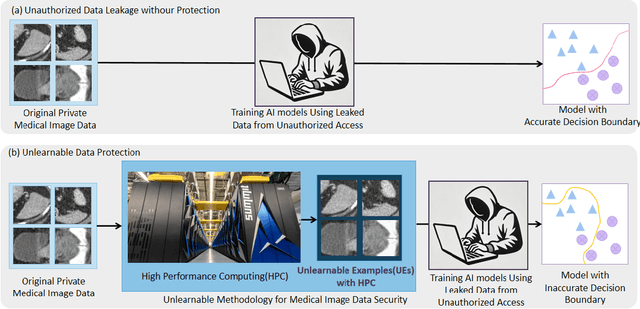

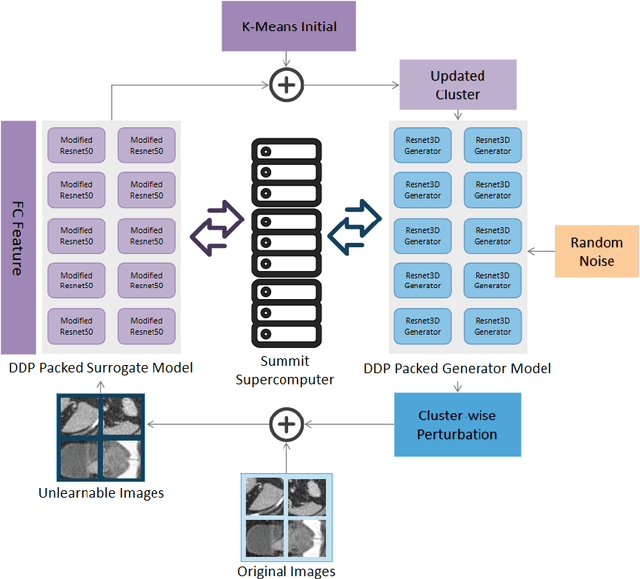
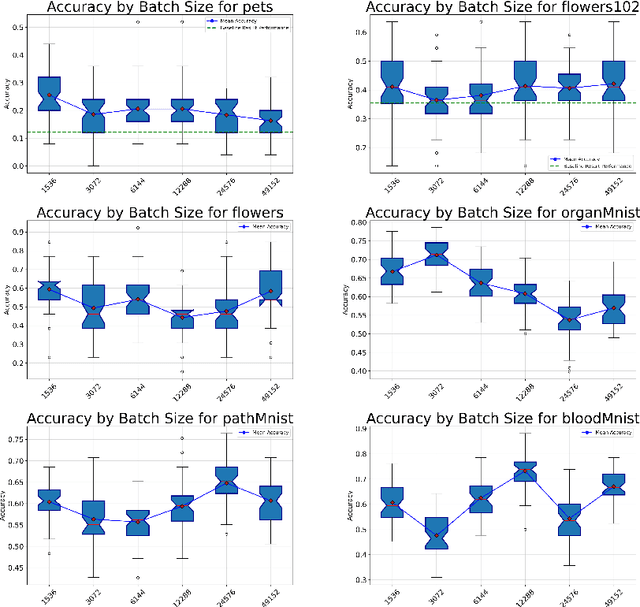
Abstract:Recent advancements in AI models are structured to retain user interactions, which could inadvertently include sensitive healthcare data. In the healthcare field, particularly when radiologists use AI-driven diagnostic tools hosted on online platforms, there is a risk that medical imaging data may be repurposed for future AI training without explicit consent, spotlighting critical privacy and intellectual property concerns around healthcare data usage. Addressing these privacy challenges, a novel approach known as Unlearnable Examples (UEs) has been introduced, aiming to make data unlearnable to deep learning models. A prominent method within this area, called Unlearnable Clustering (UC), has shown improved UE performance with larger batch sizes but was previously limited by computational resources. To push the boundaries of UE performance with theoretically unlimited resources, we scaled up UC learning across various datasets using Distributed Data Parallel (DDP) training on the Summit supercomputer. Our goal was to examine UE efficacy at high-performance computing (HPC) levels to prevent unauthorized learning and enhance data security, particularly exploring the impact of batch size on UE's unlearnability. Utilizing the robust computational capabilities of the Summit, extensive experiments were conducted on diverse datasets such as Pets, MedMNist, Flowers, and Flowers102. Our findings reveal that both overly large and overly small batch sizes can lead to performance instability and affect accuracy. However, the relationship between batch size and unlearnability varied across datasets, highlighting the necessity for tailored batch size strategies to achieve optimal data protection. Our results underscore the critical role of selecting appropriate batch sizes based on the specific characteristics of each dataset to prevent learning and ensure data security in deep learning applications.
Exploring User-level Gradient Inversion with a Diffusion Prior
Sep 11, 2024



Abstract:We explore user-level gradient inversion as a new attack surface in distributed learning. We first investigate existing attacks on their ability to make inferences about private information beyond training data reconstruction. Motivated by the low reconstruction quality of existing methods, we propose a novel gradient inversion attack that applies a denoising diffusion model as a strong image prior in order to enhance recovery in the large batch setting. Unlike traditional attacks, which aim to reconstruct individual samples and suffer at large batch and image sizes, our approach instead aims to recover a representative image that captures the sensitive shared semantic information corresponding to the underlying user. Our experiments with face images demonstrate the ability of our methods to recover realistic facial images along with private user attributes.
Analyzing Inference Privacy Risks Through Gradients in Machine Learning
Aug 29, 2024



Abstract:In distributed learning settings, models are iteratively updated with shared gradients computed from potentially sensitive user data. While previous work has studied various privacy risks of sharing gradients, our paper aims to provide a systematic approach to analyze private information leakage from gradients. We present a unified game-based framework that encompasses a broad range of attacks including attribute, property, distributional, and user disclosures. We investigate how different uncertainties of the adversary affect their inferential power via extensive experiments on five datasets across various data modalities. Our results demonstrate the inefficacy of solely relying on data aggregation to achieve privacy against inference attacks in distributed learning. We further evaluate five types of defenses, namely, gradient pruning, signed gradient descent, adversarial perturbations, variational information bottleneck, and differential privacy, under both static and adaptive adversary settings. We provide an information-theoretic view for analyzing the effectiveness of these defenses against inference from gradients. Finally, we introduce a method for auditing attribute inference privacy, improving the empirical estimation of worst-case privacy through crafting adversarial canary records.
Adaptive Recruitment Resource Allocation to Improve Cohort Representativeness in Participatory Biomedical Datasets
Aug 02, 2024Abstract:Large participatory biomedical studies, studies that recruit individuals to join a dataset, are gaining popularity and investment, especially for analysis by modern AI methods. Because they purposively recruit participants, these studies are uniquely able to address a lack of historical representation, an issue that has affected many biomedical datasets. In this work, we define representativeness as the similarity to a target population distribution of a set of attributes and our goal is to mirror the U.S. population across distributions of age, gender, race, and ethnicity. Many participatory studies recruit at several institutions, so we introduce a computational approach to adaptively allocate recruitment resources among sites to improve representativeness. In simulated recruitment of 10,000-participant cohorts from medical centers in the STAR Clinical Research Network, we show that our approach yields a more representative cohort than existing baselines. Thus, we highlight the value of computational modeling in guiding recruitment efforts.
Dataset Representativeness and Downstream Task Fairness
Jun 28, 2024



Abstract:Our society collects data on people for a wide range of applications, from building a census for policy evaluation to running meaningful clinical trials. To collect data, we typically sample individuals with the goal of accurately representing a population of interest. However, current sampling processes often collect data opportunistically from data sources, which can lead to datasets that are biased and not representative, i.e., the collected dataset does not accurately reflect the distribution of demographics of the true population. This is a concern because subgroups within the population can be under- or over-represented in a dataset, which may harm generalizability and lead to an unequal distribution of benefits and harms from downstream tasks that use such datasets (e.g., algorithmic bias in medical decision-making algorithms). In this paper, we assess the relationship between dataset representativeness and group-fairness of classifiers trained on that dataset. We demonstrate that there is a natural tension between dataset representativeness and classifier fairness; empirically we observe that training datasets with better representativeness can frequently result in classifiers with higher rates of unfairness. We provide some intuition as to why this occurs via a set of theoretical results in the case of univariate classifiers. We also find that over-sampling underrepresented groups can result in classifiers which exhibit greater bias to those groups. Lastly, we observe that fairness-aware sampling strategies (i.e., those which are specifically designed to select data with high downstream fairness) will often over-sample members of majority groups. These results demonstrate that the relationship between dataset representativeness and downstream classifier fairness is complex; balancing these two quantities requires special care from both model- and dataset-designers.
PhaseEvo: Towards Unified In-Context Prompt Optimization for Large Language Models
Feb 17, 2024



Abstract:Crafting an ideal prompt for Large Language Models (LLMs) is a challenging task that demands significant resources and expert human input. Existing work treats the optimization of prompt instruction and in-context learning examples as distinct problems, leading to sub-optimal prompt performance. This research addresses this limitation by establishing a unified in-context prompt optimization framework, which aims to achieve joint optimization of the prompt instruction and examples. However, formulating such optimization in the discrete and high-dimensional natural language space introduces challenges in terms of convergence and computational efficiency. To overcome these issues, we present PhaseEvo, an efficient automatic prompt optimization framework that combines the generative capability of LLMs with the global search proficiency of evolution algorithms. Our framework features a multi-phase design incorporating innovative LLM-based mutation operators to enhance search efficiency and accelerate convergence. We conduct an extensive evaluation of our approach across 35 benchmark tasks. The results demonstrate that PhaseEvo significantly outperforms the state-of-the-art baseline methods by a large margin whilst maintaining good efficiency.
DCR-Consistency: Divide-Conquer-Reasoning for Consistency Evaluation and Improvement of Large Language Models
Jan 04, 2024Abstract:Evaluating the quality and variability of text generated by Large Language Models (LLMs) poses a significant, yet unresolved research challenge. Traditional evaluation methods, such as ROUGE and BERTScore, which measure token similarity, often fail to capture the holistic semantic equivalence. This results in a low correlation with human judgments and intuition, which is especially problematic in high-stakes applications like healthcare and finance where reliability, safety, and robust decision-making are highly critical. This work proposes DCR, an automated framework for evaluating and improving the consistency of LLM-generated texts using a divide-conquer-reasoning approach. Unlike existing LLM-based evaluators that operate at the paragraph level, our method employs a divide-and-conquer evaluator (DCE) that breaks down the paragraph-to-paragraph comparison between two generated responses into individual sentence-to-paragraph comparisons, each evaluated based on predefined criteria. To facilitate this approach, we introduce an automatic metric converter (AMC) that translates the output from DCE into an interpretable numeric score. Beyond the consistency evaluation, we further present a reason-assisted improver (RAI) that leverages the analytical reasons with explanations identified by DCE to generate new responses aimed at reducing these inconsistencies. Through comprehensive and systematic empirical analysis, we show that our approach outperforms state-of-the-art methods by a large margin (e.g., +19.3% and +24.3% on the SummEval dataset) in evaluating the consistency of LLM generation across multiple benchmarks in semantic, factual, and summarization consistency tasks. Our approach also substantially reduces nearly 90% of output inconsistencies, showing promise for effective hallucination mitigation.
Distillation to Enhance the Portability of Risk Models Across Institutions with Large Patient Claims Database
Jul 06, 2022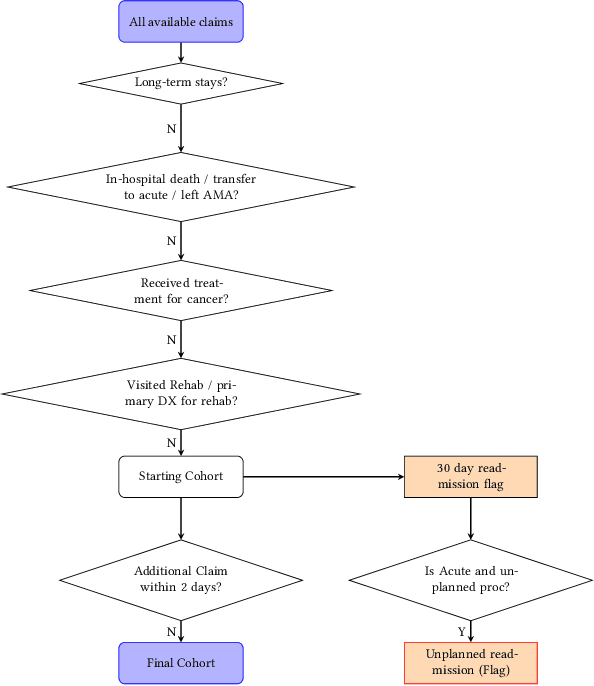

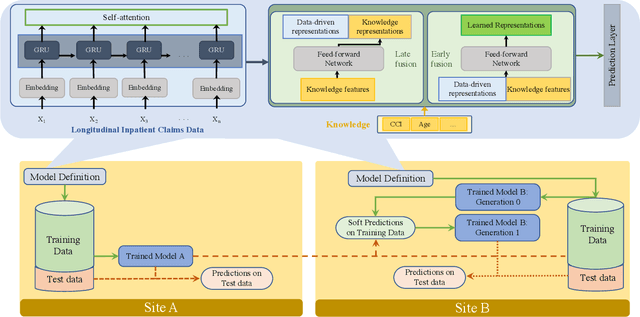

Abstract:Artificial intelligence, and particularly machine learning (ML), is increasingly developed and deployed to support healthcare in a variety of settings. However, clinical decision support (CDS) technologies based on ML need to be portable if they are to be adopted on a broad scale. In this respect, models developed at one institution should be reusable at another. Yet there are numerous examples of portability failure, particularly due to naive application of ML models. Portability failure can lead to suboptimal care and medical errors, which ultimately could prevent the adoption of ML-based CDS in practice. One specific healthcare challenge that could benefit from enhanced portability is the prediction of 30-day readmission risk. Research to date has shown that deep learning models can be effective at modeling such risk. In this work, we investigate the practicality of model portability through a cross-site evaluation of readmission prediction models. To do so, we apply a recurrent neural network, augmented with self-attention and blended with expert features, to build readmission prediction models for two independent large scale claims datasets. We further present a novel transfer learning technique that adapts the well-known method of born-again network (BAN) training. Our experiments show that direct application of ML models trained at one institution and tested at another institution perform worse than models trained and tested at the same institution. We further show that the transfer learning approach based on the BAN produces models that are better than those trained on just a single institution's data. Notably, this improvement is consistent across both sites and occurs after a single retraining, which illustrates the potential for a cheap and general model transfer mechanism of readmission risk prediction.
EVA: Generating Longitudinal Electronic Health Records Using Conditional Variational Autoencoders
Dec 18, 2020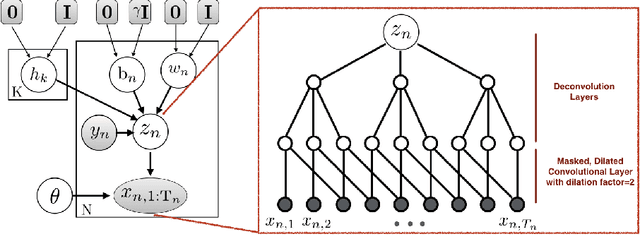
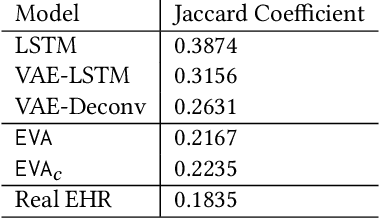

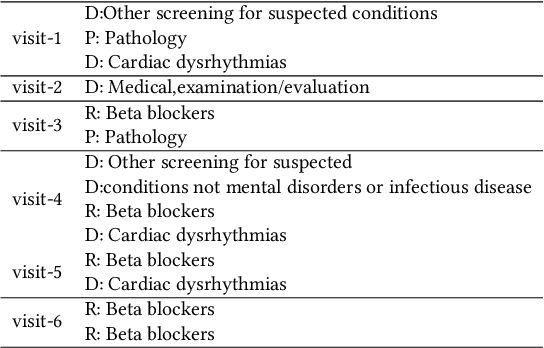
Abstract:Researchers require timely access to real-world longitudinal electronic health records (EHR) to develop, test, validate, and implement machine learning solutions that improve the quality and efficiency of healthcare. In contrast, health systems value deeply patient privacy and data security. De-identified EHRs do not adequately address the needs of health systems, as de-identified data are susceptible to re-identification and its volume is also limited. Synthetic EHRs offer a potential solution. In this paper, we propose EHR Variational Autoencoder (EVA) for synthesizing sequences of discrete EHR encounters (e.g., clinical visits) and encounter features (e.g., diagnoses, medications, procedures). We illustrate that EVA can produce realistic EHR sequences, account for individual differences among patients, and can be conditioned on specific disease conditions, thus enabling disease-specific studies. We design efficient, accurate inference algorithms by combining stochastic gradient Markov Chain Monte Carlo with amortized variational inference. We assess the utility of the methods on large real-world EHR repositories containing over 250, 000 patients. Our experiments, which include user studies with knowledgeable clinicians, indicate the generated EHR sequences are realistic. We confirmed the performance of predictive models trained on the synthetic data are similar with those trained on real EHRs. Additionally, our findings indicate that augmenting real data with synthetic EHRs results in the best predictive performance - improving the best baseline by as much as 8% in top-20 recall.
 Add to Chrome
Add to Chrome Add to Firefox
Add to Firefox Add to Edge
Add to Edge